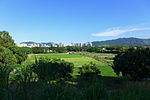Sheung Shui Slaughterhouse

The Sheung Shui Slaughterhouse (Chinese: 上水屠房; Jyutping: soeng6 seoi2 tou4 fong4) is a slaughterhouse in the outskirts of Sheung Shui, New Territories, Hong Kong. The installation was built by China State Construction. Construction began in February 1997, at a cost of HK$ 1.858 billion. It covers 5.8 hectares and is the largest slaughterhouse in Hong Kong, as well as being one of the largest in Asia according to the Architectural Services Department.As of January 2000, pollution and hygienic controls of the slaughterhouse conform to international standard, and received ISO 14001 environmental management certification. The slaughterhouse is currently managed and operated by Ng Fung Hong Limited, who were contracted by the Hong Kong Government. Today, the slaughterhouse can accommodate 12,000 pigs and 2200 cows. It is outfitted with sewage treatment, a water recycling plant and advanced slaughter machines which can operate mostly without manpower. The facility can slaughter up to 5000 pigs, 400 cows and 300 lambs per day.
Excerpt from the Wikipedia article Sheung Shui Slaughterhouse (License: CC BY-SA 3.0, Authors, Images).Sheung Shui Slaughterhouse
Chuk Wan Street, North District
Geographical coordinates (GPS) Address Nearby Places Show on map
Geographical coordinates (GPS)
| Latitude | Longitude |
|---|---|
| N 22.512795 ° | E 114.117635 ° |
Address
上水屠房 Sheung Shui Slaughterhouse
Chuk Wan Street
518005 North District
Hong Kong, China
Open on Google Maps









